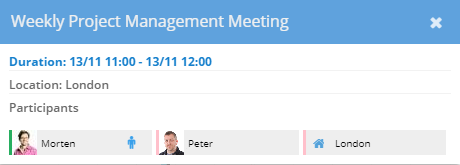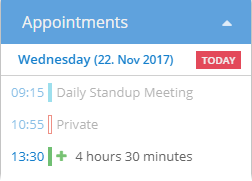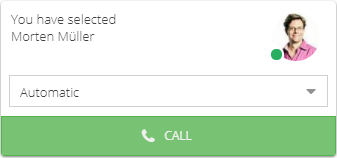Zylinc Web Agent is an upcoming product. Zylinc Web Agent hasn't been released yet, but you'll be able to get it soon.
The availability overview in the lower part of your Web Agent displays people and other resources, for example meeting rooms or queues, as well as information about their status and availability.
The amount of people and other resources you'll see in the availability overview depends on whether you've searched for someone/something or whether you've selected a specific group.

The availability overview's calendar displays people' appointments, etc.
If you can't see the calendar, place your pointer over one of the availability overview's headers, for example the Name header. Then click the small arrow, and select Columns > Calendar.
The calendar by default covers one day, but you can select a different number of days.
Colored bars in the calendar represent appointments. The length and position of a bar shows the start and end time of the appointment. The color indicates the type of appointment. Red, for example, means a private appointment. If only the outline of an appointment is colored, the person or resource is available during the appointment.
If a user has appointments that overlap, they're displayed next to each other. If you want to view all of someone's appointments on separate rows, click ![]() next to their name.
next to their name.
To view details about an appointment, click it.

When you select someone in the availability overview, you can view several types of details about them:
-
Below the availability overview, you can view their basic details.

If you see information in strikethrough, it means that the information is confidential. You can view it, and use it yourself, but you musn't give such information to others.
-
To the left of the availability overview, you can view their appointments.

-
In the active calls overview, above the availability overview, you can view available ways to call them.

Use the status icons in the availability overview to see if people of other resources are available. The status icons update themselves in real-time.
Someone can have several types of status simultaneously. For example, their mobile status can be different from the line status of their desk phone, and they may have yet another status on Skype for Business.
You can quickly view someone's overall status with unified presence (that's the ![]() column). Unified presence is a summary of someone's combined status from several sources, for example calendar, line status, mobile status, and Skype for Business, so that you can quickly tell if they're available or not:
column). Unified presence is a summary of someone's combined status from several sources, for example calendar, line status, mobile status, and Skype for Business, so that you can quickly tell if they're available or not:
![]() The person is available
The person is available
![]() The person is busy or offline
The person is busy or offline
![]() The person is away
The person is away
It's your administrator who defines which types of status are used for unified presence.
You can also view someone's individual types of status in the ![]() line status,
line status, ![]() mobile status, and Skype for Business status.
mobile status, and Skype for Business status.
To view what a specific status icon means, place your pointer over the icon.
![]()
You can sort the columns to quickly view everyone who's available. Click the column's header to sort the column.
If someone's an agent, you can view their agent status in the availability overview's ![]() agent status column:
agent status column:
![]() Agent is active
Agent is active
![]() Agent is busy
Agent is busy
![]() Agent is standby
Agent is standby
![]() Agent is inactive
Agent is inactive
If an agent goes offline, they don't have any agent status.
Again, you can sort the agent status column to quickly view every agent who's active, standby, etc.
You can forward incoming calls for specific people to someone else, for example if they're in a meeting, if they've gone for the day, or if they're on vacation.
- In the availability overview, right-click the person whose calls you want to forward, and select Set Forwarding for ...
- Select who the calls should be forwarded to
- If the selected recipient has more than one phone option, for example office and mobile phones, select the required option
- Click Set forward
As long as someone's calls are forwarded, their line status changes to ![]() in the availability overview.
in the availability overview.
To end forwarding, right-click the person whose calls are forwarded, and select Set Forwarding for .... Then click the blue box that says Currently forwarded to ... Remove?
You can't forward your own calls this way, but you have another option. See Forward your own phone & Do not disturb.
If you have the required user rights, you can quickly set absence for people, including yourself, on an ad-hoc basis. This type of absence is called an activity.
Example of an activity: Karen is at a late  lunch for the next 30 minutes.
lunch for the next 30 minutes.
When to use activity: Activity works best for quick single-case use, when the activity is an exception from someone's normal work pattern, for example a quick coffee break or a short-notice vacation. If you need more advanced options, including recurrence, try the planned absence setting instead (see Set planned absence in the following).
There are many types of activity :  in a meeting,
in a meeting,  at lunch,
at lunch,  on break,
on break,  on vacation, etc.
on vacation, etc.
Most types of activity include a time span, like in the lunch example. The only exception is  gone for today, which always covers the rest of the current day.
gone for today, which always covers the rest of the current day.
-
In the availability overview, right-click the person you want to set activity for (this can be yourself or someone else), and select Set Activity for ...
-
Select required activity.
-
Most types of activity require a time span. Click the up/down icons to select required time span. When ready, click the activity to confirm your selection.
-
You've now set the activity. It'll automatically end when the time span runs out.
If you've turned on the availability overview's Activity column, you can view the activity there. For information about how to turn columns on and off, see Customize your availability overview in the following.
To end an activity before it runs out, right-click the required person in the availability overview, select Set Activity for..., and then click Remove.
When you set ad-hoc absence, it may automatically forward the absent person's calls during the absence. Calls are typically forwarded to the absent person's mobile, but your administrator may have set it up differently. Ask your Zylinc administrator if you're in doubt.
If you have the required user rights, you can set planned absence for people, including yourself.
Example of planned absence: Karen has a doctor's appointment every morning between 10 and 11 for the next three days.
When to use absence instead of activity: Absence works great for planned away time that people haven't already registered in their calendars. With absence, you have more options: you can for example use templates to reuse absence that you've set up previously. For simple single-case scenarios, try the ad-hoc activity setting instead (see Set ad-hoc absence (quick breaks, unplanned meetings, etc.) in the previous).
-
In the availability overview, right-click the person you want to set absence for (this can be yourself or someone else), and select Set Absence
-
Specify information about the absence. These are some of the advanced options:
-
Templates: Some organizations have set up templates that cover the most common types of absence. If a suitable predefined template exists, select that template to automatically fill out the other fields.
-
Repeat Absence: If you've specified a different start date and end date, you can select whether the absence should be one continuous absence that starts and ends on those days, or whether it should be repeated every day during the period.
Example: You've set up absence for Karen between 10:00 and 11:00, with a start date of 1st March and an end date of 3rd March.
If you select Repeat Absence, Karen will be absent 1st March 10:00-11:00, 2nd March 10.00-11:00, and 3rd March 10:00-11:00.
If you don't select Repeat Absence, Karen will be absent from 1st March 10:00 until 3rd March 11:00. - Forward to mobile: Forward calls to the person's mobile phone during their absence. Not available if they don't have a mobile number.
-
-
Click Create.
The absence will appear in the list of Active Absence appointments. It's now active, and it will also appear in the person's calendar.
To delete an absence, right-click the required person in the availability overview, select Set Absence, and then  delete the absence that you don't require.
delete the absence that you don't require.
To send an e-mail or SMS text message to someone, right-click their name in the availability overview, and select Send Message. See more in Send a message to somebody in your Web Agent.
To start a chat with someone, click their Skype for Business status icon in the availability overview.
If you have the required rights, you can add people so that you can view information about them in the availability overview and other related parts of the Web Agent.
This can be relevant if someone—for whatever reason—isn't included in the availability overview, but it can also be very useful if you want to add information about a local taxi company or restaurant, so that you can view that information in the availability overview.
-
Next to the search field, click the All groups button.

The button may have another name if you have used groups to limit your searches.
-
Select the group that you want to add the person to, for example your contacts or your Events team.
People in some groups may be visible to other users of your Zylinc solution, but if you add people to other groups, they may only be visible to yourself, or to a small number of users. That depends on your groups structure. Ask your Zylinc administrator if you're in doubt..
-
Click
 .
. -
Add details about the person.
-
If required, click the Keywords tab, and add keywords about the person in the Userdefined Keywords column.
When you add keywords, you can use them in your searches. Each keyword must be on a separate line, but it's OK for a single keyword to consist of multiple words (for example Financial adviser).
-
When ready, click Save and Close.
To edit someone's details or keywords, right-click their name in the availability overview, and select Edit ...
You may need certain user rights to be able to edit someone's details. Ask your Zylinc administrator if you're in doubt.
Learn more about keywords, including the difference between user-defined keywords and system keywords, in Add or import keywords for searches.
You can sort most of the availability overview's columns if you click the headers.
You can also customize the availability overview so that it only displays the columns that you find most important: Place your pointer over one of the availability overview's headers, for example the Name header. Then click the small arrow, select Columns, and select the information that you want in your availability overview, for example:
-
Unified Presence: Summaries of people's overall status, based on their calendar, line status, mobile status, and Skype for Business status.
-
Favorite: You can add people or other resources as favorites if you right-click them in the availability overview. Your favorites are marked with a
 , and they by default appear at the top of your availability overview. This is useful for people and other resources that you often need to view.
, and they by default appear at the top of your availability overview. This is useful for people and other resources that you often need to view. -
Type: Type of resource, such as
 person,
person,  room,
room,  resource, etc.
resource, etc. -
Activity: Activity information, such as
 Lunch.
Lunch. -
Line status: Status of people's phones. Double-click a status icon to call someone's phone. If someone's phone rings, you can double-click the icon to answer the call.
-
Mobile status: Status of people's mobile phones. Double-click a status icon to call someone's mobile.
-
Skype for Business status: People's Skype for Business status. Double-click a status icon to start a chat session.
-
Calendar: The portion of the availability overview that contains the calendar.
This is help for Zylinc version 6.0. To view Zylinc unified help for other versions, go here.
© 2021 Zylinc A/S • Disclaimer
Help version: 22 January 2021 13:21:22
Share this topic: